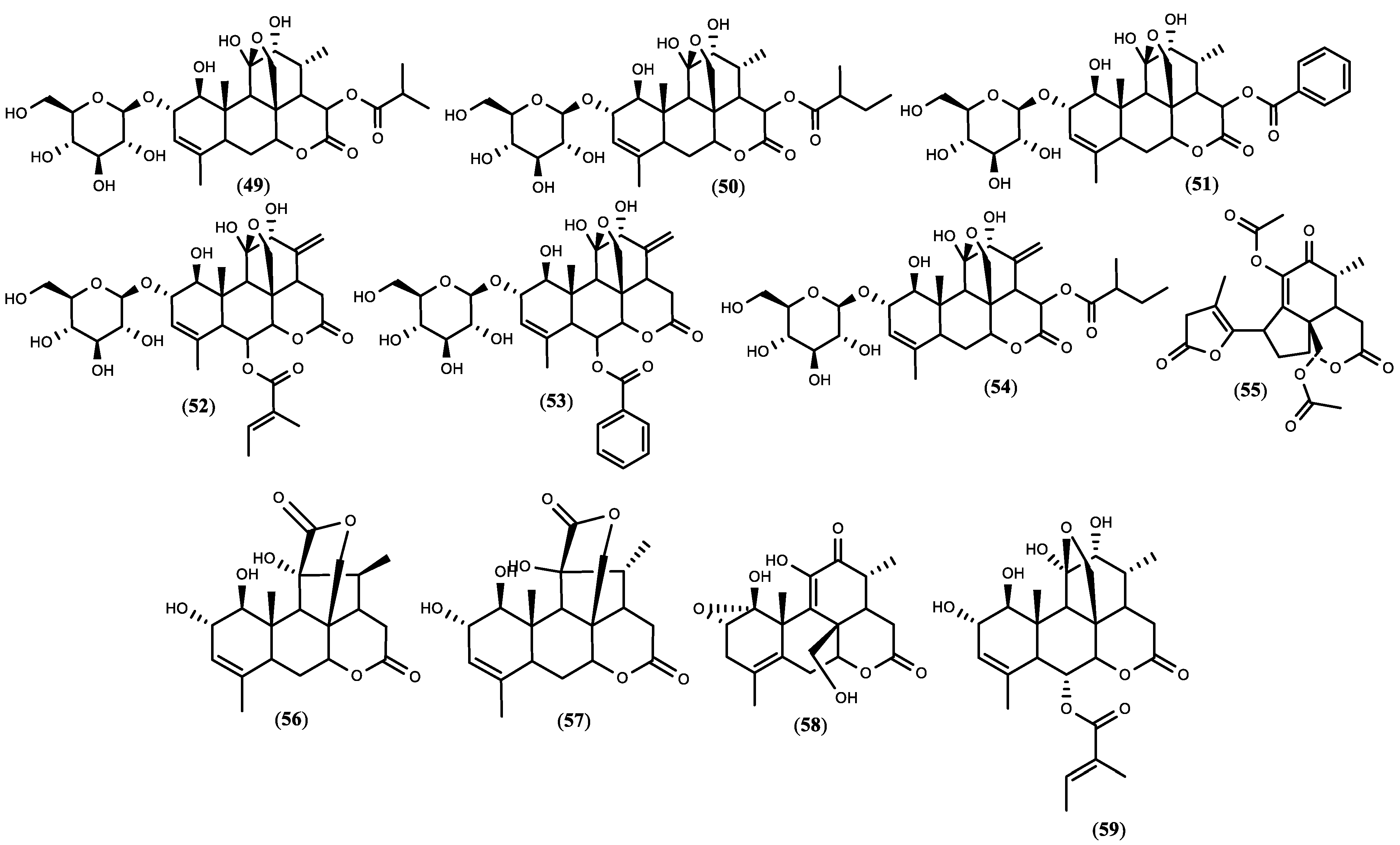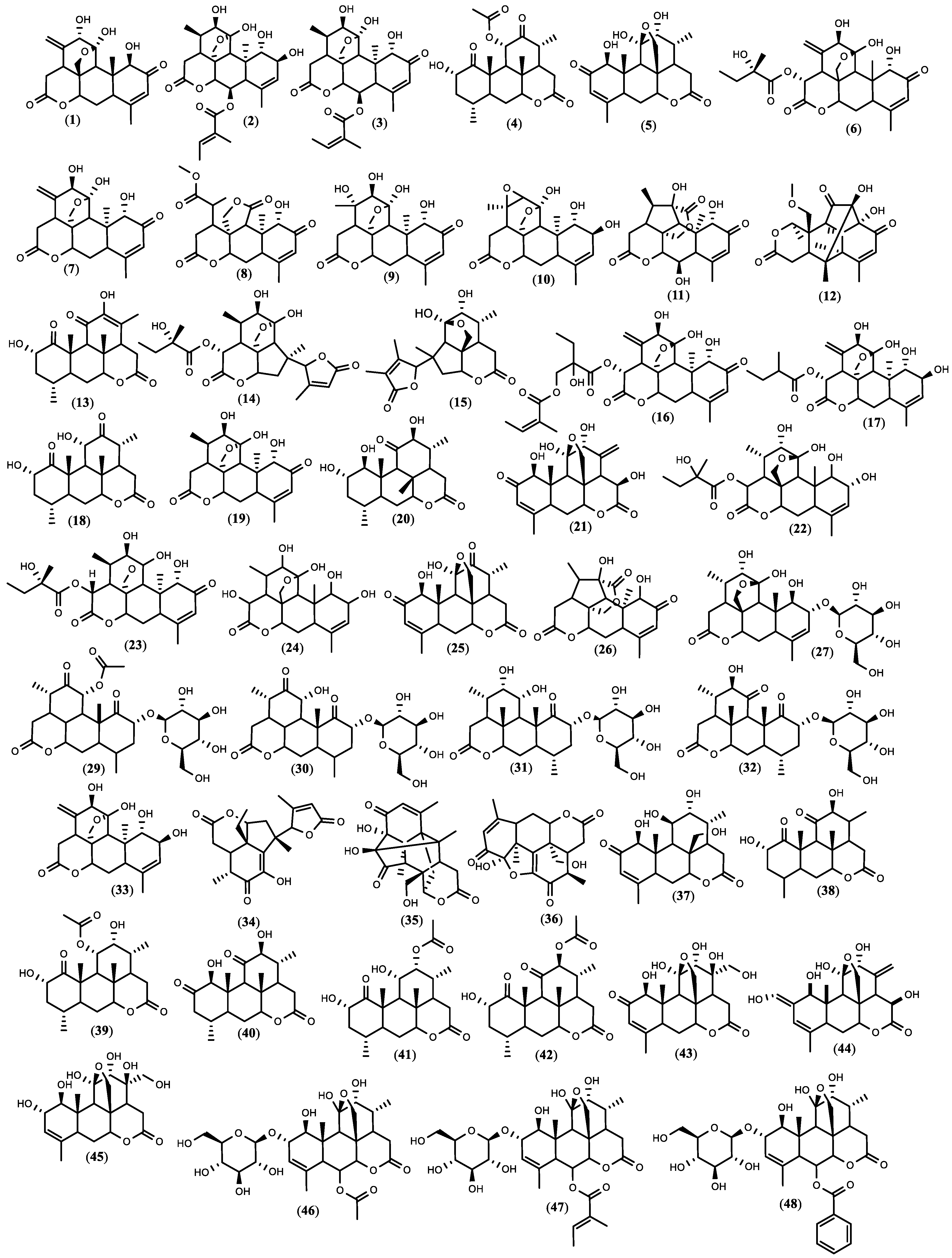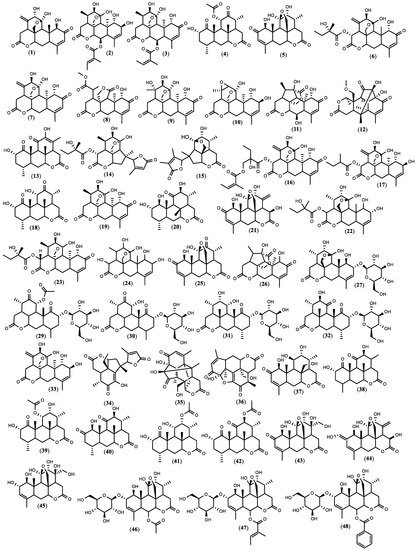1. Ethnobotanical Data about Ailanthus altissima (Mill.) Swingle
Ethnobotanical information is usually focused on the medicinal properties of plants. Therefore, information regarding the pesticide potentials of plants is valuable but scarce. For invasive plant species, ethnobotanical records are collected in their native ranges of distribution. The local human populations in these regions have established traditions in the application of such plants. The bark of
Ailanthus altissima (臭椿 chou chun) was initially recorded in Xin Xiu Ben Cao, a renowned traditional Chinese medicine monograph
[1][79]. The information within this book relates that besides the many others therapeutic effects of
A. altissima, the bark of the plant was used as an insecticide
[1][79].
A. altissima plant materials were often used in ancient China against insect predators of stored grains
[2][80]. The traditional use of
A. altissima in Chinese medicine represents the starting point for scientific research seeking evidence of such pharmacological activities, and in this particular case, its potential pesticidal effects.
2. Chemical Constituents of Ailanthus altissima and Extraction Methods
A. altissima contains various secondary metabolites such as alkaloids, terpenoids, flavonoids, essential oil, etc., with a wide range of pharmacological effects such as anti-cancer, anti-inflammatory, anti-protozoal, etc.
[1][3][4][5][6][7][8][9][10][11][12][13][14][15][79,81,82,83,84,85,86,87,88,89,90,91,92,93]. For instance, extracts of
A. altissima stems containing ailanthone possess antiplasmodial activity against
Plasmodium falciparum P. berghei [16][17][94,95]. An interesting new discovery is the antifungal effect of the alkaloid canthin-6-one isolated from
A. altissima against
Fusarium oxysporum f. sp.
cucumerinum [18][96].
Here
thwe
researchers focus on the quassinoids and essential oils as potential biopesticides since there is an indication that these groups of compounds have such effects
[19][20][21][22][23][24][25][26][27][28][9,10,11,12,13,14,15,16,17,18].
3. Essential Oil of Ailanthus altissima: Composition and Extraction Overview
The qualitative and quantitative compositions of
A. altissima essential oil vary considerably. This variability depends on the plant populations/ecological factors, the extractable parts, the ontogenesis stage, and the drying process. The main components are α-curcumene, α-gurjunene, γ-cadinene, α-humulene, β-caryophyllene, caryophyllene oxide, germacrene D, etc.
[5][29][30][31][83,97,98,99].
The extraction methods are summarized here. The collection of the materials for
A. altissima essential oil extraction may take place in the summer in Tunisia
[29][30][97,98] or in September in Croatia
[5][83]. The extraction of essential oil is a technological challenge as
the our
esearchers' own experience revealed (unpublished data). Basically, the essential oil of different plant parts (roots, stems, leaves/young and old plants, flowers, and ripe fruits, all cut into small pieces) is extracted by hydrodistillation for 3–4 h using a Clevenger-type apparatus
[5][30][83,98] or a simple laboratory Quick-fit apparatus
[29][97]. The identification of the components is performed by GC-FID and GC/MS analyses.
Additionally, the essential oil of
A. altissima bark was extracted by the Soxhlet method with anhydrous diethyl ether until the distilled liquid became colorless. The solvent was evaporated under a vacuum in a rotary evaporator and the fumigant activity was tested against four major stored grain insects
[32][100].
4. Quassinoids Extraction, Fractionation, and Isolation Overview
Quassinoids are all-chair cyclic and highly oxygenated derivatives of squalene. Biogenetically, they can be regarded as the degraded triterpenoids, which are isolated exclusively as bitter principles from plants of the Simaroubaceae family
[33][101].
A. altissima is rich in quassinoids (
Figure 1) and the process of the identification of new quassinoids is still progressing
[12][90]. The concentration of ailanthone, one of the main quassinoids, may range from 6.44 µg/mL to 825 µg/mL, depending on the source locality in China
[34][102].
 Figure 1.
Figure 1. The structure of quassinoids isolated from
A. altissima.
. The compound numbers correspond to the list in Table 1.
5. Biopesticide Potential of Ailanthus altissima and Tests’ Design
5.1. Phytotoxicity Assay of
Ailanthus altissima
Essential Oil Phytotoxicity
The essential oils of
A. altissima negatively affect the seed germination and early-stage development of the seedlings of the target species. The effect is dose-dependent and is greater in the light than in the dark. In addition, the phytotoxic effect depends on the origin of the essential oil, as the oil extracted from flowers is the most phytotoxic
[29][30][97,98]. The caryophyllene oxide, b-caryophyllene, germacrene D, and hexahydrofarnesyl acetone presented in the essential oil may be responsible for such a phytotoxic effect
[30][35][36][98,118,119]. Additionally, the complete inhibition of the germination of target plants is achieved after the application of 400 to 600 μg/mL hydrodistilled leaf residues
[29][97].
Phytotoxicity of Polar Ailanthus altissima Extracts
The juglone index
[37][120] of
A. altissima has been assessed as very high (0.80–1.40 depending on the extract concentration
[38][39][40][121,122,123]. The plant produces allelopathic substances that inhibit the seed germination and seedling growth of competing species. They are located mostly in the bark and the roots, but also occur in the leaves, seeds, and wood. The inhibitor(s) can readily be extracted from
A. altissima with methanol, but not dichloromethane, indicating the plant’s polar characteristics. The experimental tests show “striking” postemergence effects, with a nearly complete mortality of all the receiver plant species
[41][124].
The compounds of the methanolic extracts from
A. altissima’s fresh leaves and some sub-fractions have strong inhibitory effects on plant growth. Some fractions show a regulatory effect on plant by inhibiting the growth of radicles at higher concentrations and enhancing their growth at lower concentrations
[42][117]. The compounds of the aqueous extracts from
A. altissima’s fresh leaves and bark negatively influence the growth of the treated seedlings of
Sinapis alba L. and
Brassica napus L. regardless of the dilution
[43][125]. The aqueous extracts of
A. altissima leaves have a concentration-dependent herbicidal effect on
Medicago sativa L. seed germination
[44][126].
Ailanthone is highly phytotoxic, with concentrations of 0.7 mL/L causing 50% inhibition of radicle elongation in a standardized bioassay with garden cress (
Lepidium sativum L.) seeds
[45][127]. The quassinoids (from the root bark of
A. altissima), e.g., ailanthone, ailanthinone, and ailanthinol; the alkaloids such as 1-methoxycanthin-6-one; and the phenolic constituents of the leaves are potent phytotoxins
[29][46][47][48][49][50][51][57,97,128,129,130,131,132]. A significant pre-emergence herbicide activity is found for most of the bark dichloromethane extracts, which is directly correlated with the ailanthone concentration. A remarkable combined pre- and post-emergence herbicidal activity was found for a specific fraction. These results indicate that the bark of
A. altissima is a potential source for the production of natural herbicides for use in agriculture
[52][133]. Methanol bark extract with the main component ailanthone was tested for herbicidal effects under field conditions. The results show that it was quite efficient against the weeds but also caused serious injuries to the crops. Thus, a weakness of ailanthone is its non-selectivity, but a positive feature lies in its ephemeral effects. Ailanthone is easily degradable by soil microorganisms
[44][53][126,134]. It is necessary to note, however, that ailanthone is an acute toxic triterpene and should be used with caution
[54][135].
5.2. Antifungal Activity
The antifungal activity test results are contradictory and depend on the extraction methods and reagents. The methanol and ethanol
A. altissima leaves’ extracts have fungicidal activity only against
Cladosporium cladosporioides of all the tested nine species belonging to
Fusarium,
Penicillium,
Aspergillus, and
Giberella—the toxic microfungi found in cereals used for livestock and human food. However, this activity is weaker compared to the
Juglans regia leaves’ extracts
[55][136]. Ethanol, methanol, and aqueous extracts of
A. altissima were tested against
Ceratocystis manginecans (the causal agent of Mango Sudden Death) using a poisoned food technique and the treatments result in thin, collapsed/damaged hyphae compared to the control. Phytochemical profiling of the most effective extracts revealed that 9-octadecanoic acid and I-(+)- ascorbic acid 2, 6-hexadecanoate possibly contribute to the antifungal effect
[56][137]. Both acetone and methanol from the leaves’ extracts have activity against
Candida albicans, which is higher than amphotericin B, a gold standard in antifungal therapy
[9][87]. Although
C. albicans is not a crop pathogen, the result shows that further antifungal activity is worth testing. The chloroform extract of
Ailanthus excelsa stem bark shows fungistatic and fungicidal activity against
Aspergillus niger,
A. fumigatus,
Penicillium frequentence,
P. notatum, and
Botrytis cinerea [57][138]. It is the quassinoids that have been found to have inhibitory activities against plant fungal pathogens
[58][139].
5.3. Fumigant and Insect Repellent Activity
Essential Oil Fumigant and Insect Repellent Activity
The essential oil of
A. altissima bark has a fumigant activity against some pest beetles. One possible application of
A. altissima bark essential oil is for killing insects that damage stored foods or seeds, as it causes 99.3 and 81.9% mortality to
Oryzaephilus surinamensis (Linnaeus) (Coleoptera: Silvanidae) and
Sitophilus oryzae (Linnaeus) (Coleoptera: Curculionidae) with within 24 h, respectively
[2][59][60][80,140,141]. In addition, Lü and his co-workers revealed that despite its weak fumigant activity against
Tribolium castaneum (Herbst) (Coleoptera: Tenebrionidae) and
Liposcelis paeta Pearman (Psocoptera: Liposcelididae) adults, it notably repels
T. castaneum adults and
L. paeta nymphaea
[2][59][60][80,140,141]. Additionally,
A. altissima bark oil possesses high fumigant activity against
Lasioderma serricorne (Fabricius 1792) (Coleoptera: Anobiidae) adults with a mortality of 100% at 8 µL/L air within 48 h of exposure; thus, it is obviously a strong repellent of these pests
[61][142]. (Z)-3-hexen-l-ol, which is one of the main components of the essential oil extracted from
A. altissima stems
[29][97], is known as a key herbivore-induced plant volatile. There is no doubting its role as an indirect defense and this compound is a good candidate for novel insect pest control strategies
[62][143]. Additionally, caryophyllene and caryophyllene oxide, which are the main constituents of the essential oil of
A. altissima leaves and samara
[29][97], are attractive to green lacewings
[63][144]. Green lacewing larvae are predators of many soft-bodied insect pests such as: aphids, thrips, whiteflies, leafhoppers, spider mites (especially red mites), and mealybugs, and consequently they participate in biological control
[64][145]. Caryophyllene and caryophyllene oxide stimulate oviposition in green lacewings, which leads to increased larval predation against pest insects
[63][144].
A. altissima contains compounds with strong acaricidal activity against the parasitic mites that cause skin disease, namely,
Psoroptes cuniculi and
Sarcoptes scabiei var.
cuniculi [65][146]. It was also found to have activity towards nematodes of the
Meloidogyne genus
[66][147].
Polar Extracts’ Fumigant and Insect-Repellent Activity
The methanol extracts of
A. altissima fresh leaves are practically non-toxic to the mosquito
Aedes aegypti larvae
[42][117] and the leaves are even used for feeding silkworms
[67][148]. However, the methanolic extract of
A. altissima leaves causes the malformation and mortality of the larvae of the moth
Agrotis ipsilon, (Lepidoptera: Noctuidae), which are known to cause considerable damage to crops by severing young plants at the ground level. Aqueus extracts of
A. altissima leaves have oviposition-deterrence effects against
Spodoptera frugiperda (Smith) (Noctuidae), causing delays in the time to pupation and emergence in addition to reduced larval and pupal biomasses
[68][69][149,150]. This moth is considered a noxious pest because the larvae cause massive damage to various crops; consequently, insecticide sprays are employed against it
[70][151]. In addition, 0.5, 1, and 2% ethanol (70%) extracts of
A. altissima bark and leaves have strong antifeeding activity against and significant insecticidal effects on gypsy moth (
Lymantria dispar (L.)) larvae—insects known as voracious defoliating pests of deciduous trees.
The diethyl ether extract of
A. altissima possesses an extremely strong repellent effect and to a certain extent a contact-killing effect on
Oryzaephilus surinamensis (Linnaeus), the saw-toothed grain beetle
[71][152]. The ethanol extract of
A. altissima leaves possess strong acaricidal activity (97.4%) against the spider mite,
Tetranychus urticae (Koch), a plant-feeding mite generally considered to be a pest
[72][153]. The extract has no direct toxic effect on the pest but reduces its fertility about threefold and suppresses the development of larvae from eggs. The maximum efficiency of the extract was observed after 7–10 days when a filial generation of the spider mites started developing
[73][154].
Quassinoids extracted both from leaves and roots have insecticidal, antifeedant, and insect-growth-regulatory activity, and ailanthone, in particular, was found to be efficient against the aphid
Acyrtosiphon pisum [46][57]. There is a high mortality rate of aphids, pests of peas, when treated with ailanthone
[74][155]. Methanol extracts or active substances such as ailanthone, chaparinone, glaucarubinone, and 13 (18)-dehydroglaucarubinone obtained from
A. altissima leaves can be recommended for the development of new botanical insecticides targeted against the phytophagous larvae of
Spodoptera littoralis, a moth referred to as the African cotton leafworm
[75][156]. At the same time, quassinoids seems to be nontoxic for bees as they are found in propolis
[46][53][76][77][78][79][57,134,157,158,159,160]. In addition,
A. altissima bark-based hexane and methanol extracts do not possess any genotoxic, mutagenic, or carcinogenic effects on
Saccharomyces cerevisiae, which was used as a test object to evaluate the potential harm to human health
[80][161].



 Figure 1.
Figure 1.